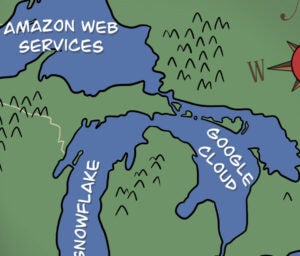 “Data-Driven Thinking” is written by members of the media community and contains fresh ideas on the digital revolution in media.
“Data-Driven Thinking” is written by members of the media community and contains fresh ideas on the digital revolution in media.
Today’s column is written by Lindsey Harju, co-founder at Blinc Digital Group.
Many in the marketing and ad tech worlds believe we’ve evolved as a society into superior beings, and in many ways, that is true.
Google Duplex shows us that we can simply ask our phone to schedule haircuts, dinner reservations and more. But despite the advancements, we are still, in many ways, mentally like caveman. Our brains are hardwired for certain functions – survival being the most pronounced.
Many of these basic psychological functions can be harnessed by data-driven marketers.
We continually scan for motion
This function [PDF] is rooted in a sense of self-preservation, constantly scanning for potential prey or predators in the wild. But even today, think about walking home or preparing to cross a road. What does this mean for marketers?
It’s simple: An ad in motion, especially unexpected motion, is more likely to grab a viewer’s attention.
We like stories
I’m sure you have heard this thousands of times, but you still may not be aware of why stories work in marketing.
“To the human brain, imagined experiences are processed the same as real experiences,” according to Pamela B. Rutledge. “Stories create genuine emotions, presence (the sense of being somewhere) and behavioral responses.”
AdExchanger Daily
Get our editors’ roundup delivered to your inbox every weekday.
Daily Roundup
Storytelling is effective regardless of the medium you choose for your campaign, but it is especially impactful in video where sight, sound and motion come together to build an even richer experience.
We like faces
From birth, infants are drawn to faces, looking to them to connect with caregivers, learn how to mimic expression and read others’ expressions to determine if a situation is safe. I have experienced “social referencing” firsthand with my children. After a fall, my son looks to my face to determine whether or not his knee hurts.
Studies show infants spend significantly longer periods of time gazing at pictures of faces compared to other objects. As we grow, we are still continuously scanning our surroundings for faces and are very efficient at finding them over other objects.
What does our love of faces mean for marketers? Since people are hardwired to continually scan for faces, a face can help capture the attention of someone with a crowded screen of ads. And when communicating a message of emotion, such as joy, fear or sadness, the use of faces can help marketers better connect to their audience.
When reading articles like this, we often default to applying the observations to consumer marketing, but you are likely communicating to clients, vendors and those in your own office. How much more impactful could your next webinar be with the use of more facial images or even the speaker’s image on screen?
You are not alone if you like blue
A study conducted by UC Berkeley’s Karen Schloss and Stephen Palmer [PDF] explored why people liked certain colors and disliked others. Their findings tied color preference back to evolutionary components, especially related to the food we consume or the fresh blue water we drink. Humans tend to like reds, which we associate with berries or apples, and dislike browns or yellows, which we associate with rotted fruit.
Overall, yellow is consistently a low performer, so marketers should be wary of using it when discussing their product; save that background for the competitive comparison.
We are mentally similar to those we are demographically similar to
I know what you are thinking: obviously.
But what is important for marketers to know is what those specific similarities and differences are. If we have consumer data to customize targeting, creative versions and channel by audience type, wouldn’t it be valuable to use psychological data to refine those choices?
For example, wealthier study participants tended to seek more unique products that helped them stand out, compared with lower-class who chose products that helped them blend in. How could that knowledge enhance a targeting strategy?
And empathy accuracy varies by consumer group. Women were able to accurately identify the emotions of strangers better than men, and those in lower social classes had higher accuracy than those in high social classes. If your ad campaign is based on emotional contagion – the tendency to feel and express emotions influenced by those of others – you may want to review those being targeted and make sure they’ll be able to pick up on the emotional cues your ad is displaying.
These insights merely scratch the surface. The human mind is incredibly complex and nuanced, and you could spend a lifetime trying to gain a deeper understanding of what is in everyone’s heads.
But as you prepare for your next campaign and are evaluating all the rich data you can get your hands on, take a few minutes to look at those audiences more closely. You can even use the cheat method: Just type “How do X people think?” into search. Evaluate the sources returned carefully, but there is a wealth of academic research on consumer behavior that could take your strategies up a level or two.
If we make understanding the minds of consumers part of our everyday process, we will create campaigns and media plans that have more impact – for us and our audience.
Follow AdExchanger (@adexchanger) on Twitter.












